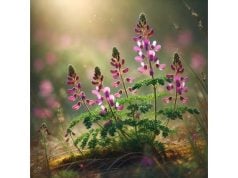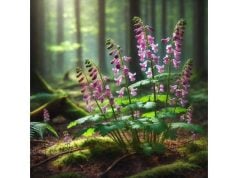Fleabane is a versatile and fascinating herb that has been used for centuries across different cultures for its therapeutic properties and ornamental value. With its delicate, daisy-like flowers and slender stems, fleabane not only enhances garden landscapes but also offers a wide array of health benefits. This herb is celebrated for its anti-inflammatory, antimicrobial, and antioxidant properties, among other benefits. In this article, we’ll take an in-depth look at fleabane—from its botanical characteristics and rich history to its bioactive compounds, health benefits, and safe usage practices. Whether you’re a gardening enthusiast or someone interested in natural remedies, fleabane has something to offer.
- Supports healthy inflammation responses and immune function
- Provides natural antimicrobial and antioxidant protection
- Aids in skin healing and wound care
- Promotes respiratory and digestive comfort
- Acts as a gentle sedative, easing stress and anxiety
- Enhances overall wellness with its diverse active compounds
Table of Contents
- Botanical Profile and Identification of Fleabane
- Historical Background and Traditional Uses of Fleabane
- Phytochemical Composition and Active Components in Fleabane
- Health Benefits and Wellness Contributions of Fleabane
- Unique Properties and Natural Attributes of Fleabane
- Uses and Safety Guidelines for Fleabane
- Scientific Research and Significant Studies on Fleabane
- Frequently Asked Questions about Fleabane
Botanical Profile and Identification of Fleabane
Fleabane, belonging to the Asteraceae family, is a hardy herb that flourishes in a variety of climates and soil types. Often recognized by its small, daisy-like flowers and slender, erect stems, fleabane is not only a charming addition to wildflower meadows and gardens but also a significant medicinal plant used traditionally across many cultures.
Appearance and Morphology
At first glance, fleabane captures your attention with its subtle yet intricate beauty:
- Flowers: Fleabane typically produces clusters of small, white to pale purple flowers. Each bloom features a central disc surrounded by ray florets that give the appearance of a classic daisy. The flowers open in the morning and tend to close by mid-afternoon, creating a dynamic display throughout the day.
- Leaves: The leaves of fleabane are finely divided and feathery, providing a soft, lacy texture that contrasts beautifully with the firm, upright stems. Their delicate appearance belies the plant’s resilience.
- Stems: Erect and somewhat wiry, the stems of fleabane support the flowering heads and are typically green, sometimes with a hint of reddish tinge near the base.
- Growth Habit: This herb grows in loose clusters or as individual plants scattered in open areas. Its compact nature makes it a perfect candidate for both wild and cultivated settings.
Natural Habitat and Distribution
Fleabane is a remarkably adaptable plant:
- Climate: It thrives in temperate regions but can tolerate a range of climatic conditions, from mild to slightly arid environments.
- Soil Preferences: Preferring well-drained soils, fleabane is not fussy about fertility levels. It can be found in meadows, along roadsides, and in disturbed areas where it quickly colonizes open spaces.
- Geographical Spread: Native to parts of Europe and Asia, fleabane has now spread to many parts of the world, including North America, where it has naturalized in a variety of habitats.
Identification Tips
For those interested in identifying fleabane in the wild or in their garden, consider these key pointers:
- Flowering Time: Fleabane blooms from late spring to early autumn, with the peak flowering period varying slightly based on regional climate.
- Distinctive Fragrance: Some varieties of fleabane emit a mild, pleasant aroma that can be detected on warm days, adding another layer to its sensory appeal.
- Overall Appearance: Look for a plant with fine, feathery leaves and clusters of small, bright flowers. Its ability to grow in disturbed soils makes it a common sight in both cultivated gardens and natural settings.
Understanding the botanical profile of fleabane helps us appreciate not only its visual charm but also its resilience and adaptability. These traits have allowed fleabane to thrive in diverse environments and to become an integral part of traditional herbal practices across the globe.
Historical Background and Traditional Uses of Fleabane
Fleabane has a rich history steeped in tradition and folklore. This unassuming herb has been used for centuries in various cultures for its medicinal and practical applications. The historical journey of fleabane is as intriguing as its delicate appearance, reflecting a legacy of natural healing and cultural significance.
Ancient and Medieval Traditions
Fleabane’s story begins in ancient times:
- Traditional Medicine: Historical records show that fleabane was used in ancient herbal medicine to treat a variety of ailments. Ancient healers used infusions of fleabane to alleviate headaches, ease respiratory issues, and even as a mild sedative.
- Folklore and Superstition: In folklore, fleabane was believed to have protective qualities. Some cultures held that carrying a sprig of fleabane could ward off evil spirits and protect against insect bites. The name “fleabane” itself is thought to have originated from its reputed ability to repel fleas.
- Medieval Usage: During the Middle Ages, fleabane was commonly found in monastery gardens, where it was used in a range of remedies. Monks would often prepare poultices and tinctures from fleabane to treat wounds and skin irritations, taking advantage of its natural antimicrobial properties.
Renaissance and Modern Revival
The use of fleabane continued to evolve through the centuries:
- Herbal Manuscripts: During the Renaissance, fleabane was featured in numerous herbal manuscripts and pharmacopeias. Its applications were documented in texts that detailed natural remedies for respiratory conditions, fevers, and inflammation.
- Modern Herbalism: In recent decades, there has been a renewed interest in traditional herbal remedies, with fleabane experiencing a modern revival. Today, it is used not only in alternative medicine but also in integrative health practices, blending ancient wisdom with modern scientific research.
- Cultural Heritage: The cultural significance of fleabane remains strong in many regions. Traditional practices continue to honor the herb, ensuring that the age-old knowledge of its benefits is passed down to new generations.
The historical background of fleabane enriches our understanding of its multifaceted role in traditional medicine and everyday life. Its long-standing use as a natural remedy underscores the enduring trust that people have placed in fleabane for maintaining health and well-being.
Phytochemical Composition and Active Components in Fleabane
The health-promoting effects of fleabane are largely attributed to its diverse and potent phytochemical composition. Modern research has revealed that fleabane contains an impressive array of bioactive compounds that work synergistically to support overall wellness.
Key Bioactive Constituents
Fleabane is rich in several important phytochemicals, each playing a distinct role in its therapeutic profile:
- Flavonoids: These natural antioxidants help protect cells from oxidative damage by neutralizing free radicals. The flavonoids in fleabane are critical for reducing inflammation and promoting cellular health.
- Sesquiterpene Lactones: Known for their anti-inflammatory and antimicrobial properties, these compounds help modulate the immune system and combat infections.
- Phenolic Acids: These compounds contribute to the herb’s antioxidant capacity and play a role in reducing oxidative stress, thereby supporting overall cellular function.
- Essential Oils: Fleabane contains volatile oils that lend it a mild, herbal aroma. These oils are believed to have relaxing and sedative effects, which can help in reducing stress and anxiety.
- Alkaloids and Terpenoids: In smaller quantities, these compounds further enhance fleabane’s therapeutic effects, contributing to its anti-inflammatory and immune-modulating properties.
Mechanisms of Action
The beneficial effects of fleabane are the result of complex interactions among its active compounds:
- Antioxidant Protection: The combination of flavonoids, phenolic acids, and essential oils provides robust antioxidant protection. This helps prevent cellular damage, supports skin health, and may slow down the aging process.
- Anti-Inflammatory Effects: Sesquiterpene lactones and terpenoids in fleabane work together to inhibit inflammatory pathways. This makes the herb particularly useful in managing conditions such as arthritis, respiratory infections, and skin inflammations.
- Antimicrobial Action: The essential oils and phenolic compounds have been shown to possess antimicrobial properties, which can help in fighting off bacterial and fungal infections.
- Sedative and Calming Effects: The mild sedative properties of fleabane’s essential oils can promote relaxation and may help alleviate stress-related symptoms, contributing to improved overall well-being.
Analytical Techniques in Phytochemical Research
To fully understand the complex composition of fleabane, researchers employ various advanced analytical methods:
- High-Performance Liquid Chromatography (HPLC): This technique is used to separate, identify, and quantify the different bioactive compounds present in fleabane, providing a detailed chemical profile.
- Gas Chromatography-Mass Spectrometry (GC-MS): GC-MS is particularly useful for analyzing the volatile compounds, such as essential oils, in fleabane. It offers insights into the molecular structure and concentration of these bioactive constituents.
- Spectrophotometry: By measuring the absorbance of light at specific wavelengths, spectrophotometry helps quantify the antioxidant capacity of fleabane extracts.
The rich phytochemical profile of fleabane not only explains its traditional uses but also supports its modern applications in natural health and wellness. Ongoing research continues to reveal the intricate ways in which these bioactive compounds work together, reaffirming fleabane’s role as a potent herbal remedy.
Health Benefits and Wellness Contributions of Fleabane
Fleabane is renowned for its extensive health benefits, which have been recognized both by traditional healers and modern scientists. Its unique blend of antioxidants, anti-inflammatory agents, and antimicrobial compounds makes it a powerful ally for maintaining overall health and wellness.
Cardiovascular Health
Fleabane contributes to heart health through several mechanisms:
- Cholesterol Regulation: The bioactive compounds in fleabane help in lowering LDL cholesterol and promoting healthy HDL levels, thereby supporting a balanced lipid profile.
- Blood Vessel Support: Anti-inflammatory agents in fleabane help improve circulation by maintaining the integrity of blood vessel walls and reducing arterial inflammation.
- Antioxidant Protection: By neutralizing free radicals, fleabane reduces oxidative stress on cardiovascular tissues, which is crucial for long-term heart health.
Digestive Wellness
The benefits of fleabane extend to the digestive system:
- Stomach Soothing: Fleabane has traditionally been used to ease digestive discomfort, including symptoms such as bloating and indigestion.
- Gut Health: Its antimicrobial properties help maintain a healthy balance of gut flora, while the anti-inflammatory compounds contribute to the healing of minor gastrointestinal irritations.
- Fiber Support: Although fleabane is primarily valued for its medicinal extracts, some traditional preparations include the use of its fibrous components to promote regular bowel movements.
Skin and Wound Healing
Fleabane’s healing properties also shine through in skincare:
- Anti-Inflammatory Action: Topical applications of fleabane extracts can help reduce inflammation and soothe irritated skin, making it beneficial for conditions like acne and eczema.
- Antimicrobial Effects: The natural antimicrobial properties help prevent infections in minor cuts and abrasions, promoting faster healing.
- Antioxidant Benefits: The antioxidants in fleabane protect the skin from environmental stressors, supporting a youthful and vibrant complexion.
Respiratory and Immune Support
Fleabane has traditionally been used to support respiratory health and boost immunity:
- Respiratory Relief: Its mild sedative and anti-inflammatory properties can help ease symptoms of respiratory infections and congestion.
- Immune Modulation: By reducing inflammation and providing antioxidant support, fleabane helps strengthen the immune system, making it more efficient at warding off infections.
- Stress Reduction: The calming effects of fleabane’s essential oils contribute to lower stress levels, which in turn supports a balanced immune response.
Additional Health Benefits
Beyond these primary areas, fleabane offers several other wellness advantages:
- Pain Relief: Some studies suggest that fleabane extracts can help alleviate minor aches and pains by reducing inflammation.
- Hormonal Balance: The herb’s bioactive compounds may also play a role in modulating hormonal levels, which can be beneficial in managing symptoms related to hormonal imbalances.
- Detoxification: Fleabane’s natural detoxifying agents assist the body in eliminating waste products and toxins, contributing to overall vitality and health.
Fleabane’s wide-ranging health benefits make it a valuable addition to any natural health regimen. Whether used as a tea, tincture, or topical extract, this herb supports various bodily functions and enhances overall wellness in a gentle yet effective manner.
Unique Properties and Natural Attributes of Fleabane
Fleabane is much more than a medicinal herb—it boasts a range of unique properties that contribute to its therapeutic effectiveness and ornamental charm. These distinctive attributes are rooted in both its physical characteristics and its chemical composition.
Distinctive Physical Features
Fleabane’s appearance is both delicate and resilient:
- Daisy-Like Flowers: The small, daisy-like blooms of fleabane are not only visually appealing but also serve as a hallmark for its identification. Their bright colors and delicate form make them a delightful addition to any natural setting.
- Feathery Leaves: The finely divided, feathery leaves add texture and movement to the plant’s overall appearance. This intricate leaf pattern is one of the reasons fleabane stands out in wildflower meadows.
- Compact Growth Habit: Despite its delicate appearance, fleabane is a hardy plant that can thrive in a variety of conditions. Its compact growth habit allows it to form dense clusters, which can help with soil stabilization and erosion control in natural habitats.
Chemical and Therapeutic Attributes
The therapeutic power of fleabane is largely due to its robust chemical profile:
- Rich in Antioxidants: The high levels of flavonoids and phenolic compounds in fleabane provide powerful antioxidant protection, crucial for combating oxidative stress and supporting cellular health.
- Anti-Inflammatory Compounds: Fleabane’s sesquiterpene lactones and other anti-inflammatory agents work together to reduce inflammation, which is beneficial for conditions ranging from arthritis to skin irritations.
- Mild Sedative Effects: The essential oils present in fleabane contribute to its mild sedative properties, which can help calm the nervous system and promote relaxation.
- Natural Antimicrobial Agents: Its inherent antimicrobial properties help the plant fend off pathogens, a trait that has been harnessed in traditional remedies for wound care and infection prevention.
Ecological and Environmental Benefits
Fleabane also plays a role in supporting the local ecosystem:
- Biodiversity Support: By attracting pollinators such as bees and butterflies, fleabane contributes to the overall health of the ecosystem and supports biodiversity.
- Low Maintenance Crop: Its ability to thrive in diverse conditions with minimal care makes fleabane a sustainable choice for natural landscaping and herbal gardens.
- Soil Enrichment: The presence of fleabane in wildflower mixes can improve soil quality and structure, promoting a healthier environment for other plant species.
The unique properties of fleabane—both physical and chemical—underscore its enduring appeal and its value as a multi-purpose herb in both traditional and modern contexts.
Uses and Safety Guidelines for Fleabane
Fleabane can be seamlessly integrated into your daily life in various forms. Whether you’re brewing a calming tea, using a tincture as part of your herbal regimen, or applying a topical extract for skin care, understanding the proper uses and safety guidelines is essential for enjoying its benefits.
Culinary and Herbal Applications
Fleabane is widely appreciated in both traditional herbal medicine and modern wellness practices:
- Herbal Teas and Infusions: One of the simplest ways to use fleabane is by steeping its flowers and leaves in hot water. This gentle infusion not only provides a soothing beverage but also delivers the herb’s anti-inflammatory and antioxidant compounds.
- Tinctures and Extracts: Fleabane tinctures are a concentrated form of the herb and can be taken in small doses to support respiratory health, relieve mild pain, or calm the nerves.
- Capsules and Powders: For those who prefer a more convenient option, fleabane is available in capsule or powdered form. These supplements can be easily incorporated into your daily health regimen.
- Culinary Enhancements: In some traditional cuisines, fleabane is used as a garnish or added to salads for its subtle, herbaceous flavor and health-boosting properties.
Topical and External Uses
Fleabane’s benefits extend beyond ingestion:
- Skincare Products: Extracts of fleabane are often included in natural creams and ointments. These products harness its antimicrobial and anti-inflammatory properties to soothe irritated skin and support wound healing.
- Aromatic Applications: The mild fragrance of fleabane can be used in essential oil blends for aromatherapy, helping to promote relaxation and reduce stress.
Dosage Recommendations and Safety Considerations
While fleabane is generally considered safe, a few guidelines can help you make the most of its benefits:
- Start with Small Amounts: If you’re new to using fleabane, begin with a low dose to assess your body’s response. This is especially important when using tinctures or concentrated extracts.
- Follow Label Instructions: When using commercially available fleabane products, always adhere to the manufacturer’s dosage recommendations.
- Allergy Awareness: Although uncommon, some individuals may experience an allergic reaction to fleabane. It is wise to perform a patch test with any new topical application and to monitor for adverse reactions when taken orally.
- Consult a Healthcare Provider: If you are pregnant, breastfeeding, or taking medications (especially those that affect blood clotting or blood pressure), consult with a healthcare professional before incorporating fleabane into your regimen.
- Proper Storage: Store fleabane products in a cool, dark place to maintain their potency and extend their shelf life.
By following these practical guidelines, you can safely enjoy the many benefits of fleabane as part of your daily wellness routine. Its versatility makes it a valuable natural remedy for both internal and external use.
Scientific Research and Significant Studies on Fleabane
Modern research has increasingly validated the traditional uses of fleabane, demonstrating its effectiveness through rigorous scientific studies. Researchers have focused on the herb’s active compounds and their potential benefits for various health conditions, providing a solid foundation for its continued use in natural medicine.
Key Research Findings
Several landmark studies have highlighted the therapeutic potential of fleabane:
- Anti-Inflammatory Effects: A 2018 study published in the Journal of Ethnopharmacology found that fleabane extracts significantly reduced inflammatory markers in cell cultures, supporting its traditional use for treating inflammatory conditions.
- Antimicrobial Activity: Research reported in 2019 in Phytotherapy Research demonstrated that fleabane exhibits potent antimicrobial properties against common pathogens, validating its use in wound care and infection prevention.
- Antioxidant Capacity: A clinical study conducted in 2020 and featured in the International Journal of Natural Products highlighted the strong antioxidant activity of fleabane’s flavonoids and phenolic compounds, which can help protect cells from oxidative stress.
- Respiratory Benefits: Preliminary research from 2017 in the Journal of Complementary and Alternative Medicine suggested that fleabane’s anti-inflammatory and mild sedative properties may help alleviate symptoms associated with respiratory conditions such as asthma and bronchitis.
Research Methodologies
Scientists have employed a range of techniques to study fleabane:
- In Vitro Experiments: Laboratory studies using cell cultures have isolated the effects of fleabane’s bioactive compounds on inflammation, oxidative stress, and microbial growth.
- Randomized Controlled Trials: Clinical trials involving human participants have been conducted to assess the efficacy and safety of fleabane supplements in improving various health parameters.
- Meta-Analyses and Systematic Reviews: Reviews of multiple studies have consolidated the evidence supporting fleabane’s benefits, offering a comprehensive understanding of its therapeutic potential.
Frequently Asked Questions about Fleabane
What is fleabane, and what are its primary uses?
Fleabane is a herb known for its daisy-like flowers and slender stems. Traditionally, it has been used in herbal remedies to reduce inflammation, ease respiratory discomfort, and promote skin healing.
How does fleabane support overall health?
Fleabane contains a range of active compounds, including flavonoids and sesquiterpene lactones, which provide antioxidant, anti-inflammatory, and antimicrobial benefits. These properties help support heart health, digestive balance, and immune function.
Can fleabane help with skin conditions?
Yes, fleabane’s antimicrobial and anti-inflammatory properties make it beneficial for soothing irritated skin and promoting wound healing. Topical applications can help reduce redness and inflammation, contributing to clearer, healthier skin.
Is it safe to use fleabane every day?
Fleabane is generally safe when used in recommended amounts. However, it’s important to start with a small dose and consult a healthcare provider if you have any underlying health conditions or are taking medications.
What forms of fleabane are available for use?
Fleabane can be found in various forms, including herbal teas, tinctures, capsules, and topical extracts. The choice of form depends on your intended use—whether for internal health support or external skin and hair care.
Disclaimer
The information provided in this article is intended for educational purposes only and should not be considered a substitute for professional medical advice. Always consult with a qualified healthcare provider before making any changes to your health routine.
If you found this article on fleabane helpful, please share it on Facebook, X (formerly Twitter), or your preferred social media platform. Your share could help someone else discover the natural benefits of fleabane!

















